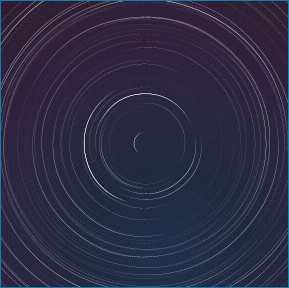Rob Carlson responded to my post last night about Precession and asked about the Northern Celestial Pole (NCP) I mentioned. Explaining this deserves its own entry, so here we go.
We all know that Earth rotates on its polar axis. This gives us night and day. This makes the Sun rise in the east and set in the west, as well as the stars and moon at night. Basic stuff.
The Celestial Poles (there's a North and a South one) are points in the sky that we, standing on earth, see all objects in the sky (the Sun, the Moon, the stars) revolve around. So, if we pointed a camera directly at the Northern Celestial Pole and held the shutter open for a few hours, we would see that the stars made a circular pattern around this point, giving a picture that would look like this:

The star Polaris, the "North Star", is almost exactly positioned at this point in the sky (In the picture above, that small arc near the center is Polaris). There's a Southern Celestial Pole, too, but we in the Northern Hemisphere don't see it, just as people in the Southern Hemisphere don't see our Northern Celestial Pole and Polaris, they see their own. But we up here are lucky, we have a star (Polaris) that's almost right on the NCP. The people down under don't have a "South Star" because there's no star close enough to the SCP to be called that.
To help visualize this movement, I made a movie. In this movie, we are looking at the point in the sky called the NCP. You will see the star Polaris right next to it (within 1 degree.) I will then speed up time so you will see a full 24 hour rotation in the movie.
You can see this movie (Quicktime Format, 1.2MB) by clicking here.